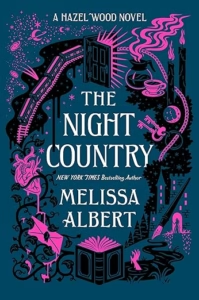The Night Country (The Hazel Wood #2)
Melissa Albert
Flatiron Books
Published January 7, 2020
Amazon | Bookshop | Goodreads
About The Night Country
The New York Times bestselling sequel to Melissa Albert’s beloved The Hazel Wood!
In The Night Country, Alice Proserpine dives back into a menacing, mesmerizing world of dark fairy tales and hidden doors of The Hazel Wood. Follow her and Ellery Finch as they learn The Hazel Wood was just the beginning, and that worlds die not with a whimper, but a bang.
With Finch’s help, Alice escaped the Hinterland and her reclusive grandmother’s dark legacy. Now she and the rest of the dregs of the fairy tale world have washed up in New York City, where Alice is trying to make a new, unmagical life. But something is stalking the Hinterland’s survivors—and she suspects their deaths may have a darker purpose. Meanwhile, in the winking out world of the Hinterland, Finch seeks his own adventure, and—if he can find it—a way back home…
My Review
Yay, I finished a series! Okay, there were literally only two books in this one, but it still feels like an accomplishment for me. I read The Hazel Wood last year. It was a total impulse read for me. I’d been waiting on something else to be available at the library, so I picked up The Hazel Wood (available immediately) instead. Fast-forward to this year, when I finally decided I was ready to revisit Alice and Finch’s stories and see how it all ends.
I think one of the things that’s really interesting about this series is how minor the romantic thread is. The first book barely brings romance into the story and ends without resolving the romance. There is some romance in The Night Country, but it is VERY subplot. The characters do pine for one another more, but the feelings are more background than plot, if that makes sense.
After the grisly, immersive fairytales of the first book, I wasn’t sure how Albert was going to pull off crafting a story landscape that rivaled The Hazel Wood. I loved the lore of The Night Country and how it tied together with the mysterious deaths Alice was tracking.
This is one of those stories that seems to have a lot of disparate pieces, and then all of them snap together in a very satisfying way. I love it when an author can pull that off well, and I thought it was well done here.
This is definitely a “read the first book first” kind of series, but if you enjoyed the first book, definitely check this one out if you haven’t already. And if you love creepy fairytales and sinister magic, put this duology on your reading list.
Content Notes
Recommended for Ages 14 up.
Profanity/Crude Language Content
Strong profanity used fairly frequently.
Romance/Sexual Content
Kissing.
Spiritual Content
Some characters can use magic. Multiple worlds exist, and some characters learn to navigate between them. Some characters can see the future or make predictions. Three characters spend a lot of time in a church, though the church leadership wants them to leave.
Violent Content
Situations of peril. Vague references to a man harming (including murdering) women. Alice tracks a serial murderer who mutilates their victims, taking a single body part from each person.
Drug Content
Alice drinks alcohol and another strong drink that alters her mental/physical state.
Note: This post contains affiliate links, which do not cost you anything to use but help support this blog. I borrowed a copy of this book from my library. All opinions are my own.
